Discover recreational opportunities in Eastern, North Central, South Central, North Puget Sound, Southwest, and Coastal Washington.
Celebrate Earth Month with fish and wildlife-related recreation
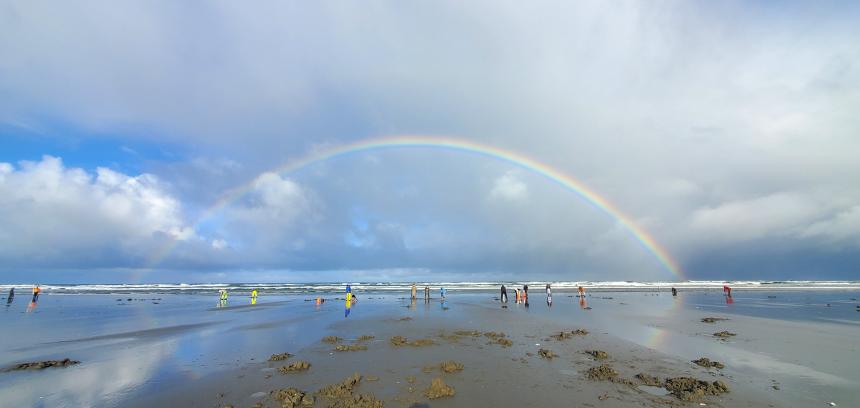
From trout fishing and clam digs to spring turkey hunting and wildlife watching, there's a way for everyone to get outdoors.
Lowland lakes trout fishing opens April 27, with annual statewide trout derby
As Earth Day and Earth Month approach, many outdoor enthusiasts are excited for the start of the statewide lowland lakes fishing season, which begins April 27. This fishing opener attracts hundreds of thousands of Washingtonians who enjoy lakes across the state stocked with trout, and in some areas, other fish. Search for local fishing spots, with information on bank access, what’s in the water, and when it’s biting, on the lowland lakes page. You can also find out how many fish the Washington Department of Fish and Wildlife (WDFW) stocked in each lake by checking the stocking reports.
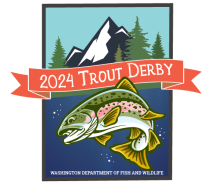
April 27 is also the kickoff for the Department’s annual statewide trout derby, which runs through Oct. 31 at more than 100 stocked lakes. Over 100 participating businesses are offering more than 800 prizes valued at over $42,000. The derby is open to anyone with a valid 2024 fishing license, though temporary licenses are not valid for game fish species from April 27 to May 1. There is no entry fee or registration required. You just catch a tagged trout anytime between April 27 and Oct. 31 and you win! Plus, children under 15 fish for free.
Visit the derby information page in early April to find a participating lake near you and learn more about how the derby works.
Buy your 2024 fishing, shellfishing, or hunting license
Now that spring has arrived, Washingtonians will need to buy 2024-2025 recreational hunting and fishing licenses effective April 1. People can buy licenses from WDFW’s licensing website, WDFW regional offices, or hundreds of license vendors around the state.
Special hunt applications now available
Multi-season deer and elk tags allow you to hunt archery, muzzleloader, and modern firearm seasons, while special hunt permits offer opportunities such as hunting outside general seasons, all increasing your chances for success. Learn more, including details on the May 15 special hunt application deadline, at myWDFW.com.
Events with WDFW: Family fishing, Earth Day, trout derby kickoff, and more
Looking for opportunities to get outdoors with friends and family? Join WDFW at one of our signature family fishing or Earth Day events. Check out the WDFW events calendar for a full list of events.
Family fishing events: These are designed for youth and families of all skill levels and are a great opportunity for beginners to try fishing. Join us for the first event of the season, the Camp Lakeview Family Fishing Event on Saturday, April 6 in Pierce County, or another one! Information on upcoming family fishing events can be found on the WDFW calendar.
Earth Day events: Our series of Earth Day events continues to grow, featuring opportunities to volunteer in Thurston County or Jefferson County on Saturday, April 20, an Earth Day Cleanup at the Chehalis Unit in Grays Harbor County on Monday, April 22, or another event!
Other events:
- Wildlife Wednesday Speaker Series: Owls Abound – Wednesday, April 3 from 6:30 to 8 p.m. at the White Center Library in Seattle and available via Zoom
- Introduction to Bats of Washington & Marrowstone Island – Wednesday, April 10 from 5 to 6 p.m. online. Pre-register on Eventbrite.
- Washington State Spring Fair – WDFW will have a booth April 11 to 14 at the Washington State Fairgrounds in Puyallup
- Trout Derby Kickoff Party – April 13 from 10 a.m. to 2 p.m. at the Filson Flagship store in Seattle's SODO neighborhood. Please note the 2024 Trout Derby begins April 27.
- Arbor Fest – April 13 from 10 a.m. to 3 p.m. at the Yakima Area Arboretum
- Spring Spectacular – April 13 from 9:30 a.m. to 4 p.m. at Woodland Park Zoo in Seattle
- Salmon Summit – April 15-16 from 10 a.m. to 1:30 p.m. in Richland
- Aquatic Species Restoration Plan Symposium – April 17-18 from 9 a.m. to 4 p.m. at Centralia College
- Lowland lakes opener and trout derby kickoff – April 27, statewide (see recently stocked lakes)
Complete hunter education to prepare for spring turkey season
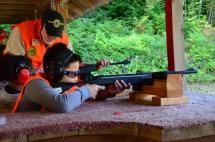
WDFW urges new, prospective hunters to complete hunter education before upcoming turkey hunting seasons. Youth turkey season opens April 1, and the general spring turkey season opens April 15. Check out our news release and the Wild Turkey Spring Season hunting regulation pamphlet for details.
For those interested in learning more about upcoming outdoor activities, the Weekender Regional Reports provide updated information about recreational opportunities around the state, helping to make Earth Month a time to connect with nature and promote sustainable outdoor practices.
Popular outdoor opportunities this month
Trout fishing in Eastern Washington
Spring sunshine also means the start of runoff in many Eastern Washington rivers and creeks, though the Yakima River from Roza Dam to Easton Dam and other tailwaters below dams often fish well this month depending on river levels. Gear or flies that imitate earthworms and stoneflies tend to be effective during high water. There are also many lakes, ponds, and reservoirs across central and eastern Washington with hungry trout, bass, and panfish becoming more active as waters warm.
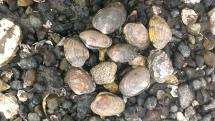
Gather oysters and clams during daytime low tides
Daytime low tides throughout April offer some of the year’s best opportunities to gather oysters, mussels, and clams from Puget Sound beaches before our state’s inland marine waters begin to warm later in spring. Check out our webpage and news release for more information and regulations, and be sure to always check the Department of Health's shellfish safety interactive map before gathering shellfish. We also have more tips in a series of four blogs published last spring.
Columbia River spring Chinook fishery
Starting April 1, the popular fishery expands upstream from Bonneville Dam to the Washington/Oregon state line above McNary Dam. See our news release for more details and regulations.
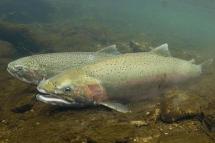
Steelhead fishing on the Skagit River and lower Columbia River tributaries
Fishing for steelhead is open five days per week, Saturdays through Wednesdays only, on portions of the iconic Skagit and Sauk rivers. This popular catch-and-release fishery is scheduled to remain open through April 17. See our news release for detailed regulations. The Cowlitz, Kalama, and North Fork Lewis rivers are open year-round for steelhead and trout, and typically fish well in April for both hatchery and wild steelhead. Coastal rivers will close for the winter steelhead season after March 31.
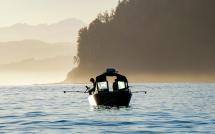
Winter Chinook salmon in marine areas
Marine Area 5 (Sekiu and Pillar Point) in the western Strait of Juan de Fuca is scheduled to be open through April 30 for hatchery Chinook. See our recent blog post for tips. Marine Area 11 (Tacoma-Vashon Island) remains open four days per week, Wednesdays through Saturdays only, through April 15 or until the fishery guidelines are met. Marine Area 13 (South Puget Sound) is open year-round. You can also try for resident coho in Marine Area 13 casting a fly or spinner, and they’re often accessible from shore at spots such as Purdy Bridge and Narrows Park. Marine Area 10 (Seattle/Bremerton areas) is closed after winter Chinook guidelines were met. Always check current regulations before salmon fishing. For tips, visit our salmon fishing webpage.
Halibut fishing in Puget Sound and Straits
The 2024 halibut season kicks off April 4 in several Puget Sound marine areas. See our halibut season news release or webpage for details. The 2024 halibut season is structured similarly to last season with Marine Areas 5, 6, 7, 8, 9, and 10 opening on the same date and scheduled to be open through June 30, seven days per week. There is a one halibut daily catch limit and no minimum size restriction.
Coastal razor clam digging
Razor clam enthusiasts can make tentative plans to head to selected coastal beaches on digs planned for April 6-14 and April 23-29. Additional information can be found by visiting the WDFW coastal razor clam webpage. All diggers age 15 or older must have an applicable fishing license to harvest razor clams on any beach. Looking ahead, shellfish and seafood enthusiasts should make plans to attend the Long Beach Razor Clam Festival on May 10-11.
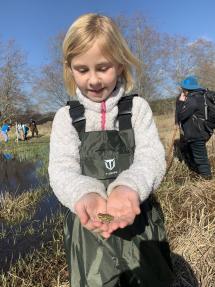
Wild Washington youth education program
April 22 is the 54th annual Earth Day. This holiday is a great way to celebrate Earth and the services it provides, like clean air and water, pollution control, and food. It’s also a great time to give back to our planet through volunteering.
Check out official Earth Day events throughout Washington or Earth Day events WDFW is attending on our calendar. Many events will take place on April 20 this year. You can also celebrate Earth Month with your family through WDFW family educational resources focused on stewardship. These resources are a great way to become a fish and wildlife steward in or near your home.
Leave wild babies wild
April is a busy month for the birth of baby animals. If you find fawns, baby birds, or other young animals, please leave them be, even if they appear to be orphaned or abandoned. Most animals have a parent foraging or hunting nearby. Read our blog to learn about when not to rescue wildlife and what to do if you encounter certain species.
Practice black bear awareness this spring
When awakening from hibernation, black bears look for high-calorie foods that are easy to get. These may include garbage, bird feeders (both seed and liquid), fruit trees, and pet food. Removing these attractants is the best way to encourage bears to move along and focus on natural food sources. More information on living with bears is available on our website.
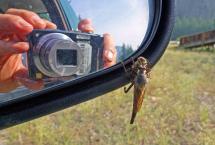
City Nature Challenge: April 26-29
From April 26-29, cities around the world are teaming up with community members and iNaturalist to observe the wildlife around them. To participate, take pictures of all of the wild animals and plants you see and upload them to the iNaturalist app or website.
Following the challenge, experts will identify the wildlife in your images! Communities around the state are hosting wildlife viewing events. Join the Palouse Region, Kitsap County, Seattle-Tacoma, Vancouver, Thurston County, Spokane, or Global Project challenges!
A balancing act: Managing sustainable fisheries in the Columbia River
From its headwaters in British Columbia to the Pacific Ocean, the Columbia River sustains diverse species, communities, and economies. WDFW works with other states, federal entities, and tribes to co-manage Columbia River fisheries. This spring, we’ll be sharing a series of videos and blogs to dive into the details of managing these fisheries. Managing Columbia River fisheries is a complex, science-based process. We’re all working together to balance the river’s fish stocks and ecosystems while offering sustainable fishing opportunities.
Join the WDFW team
If you'd enjoy preserving, protecting, and perpetuating the state's fish, wildlife, and ecosystems while providing sustainable fish and wildlife recreational and commercial opportunities, then check out some of our current job openings or sign up for job alerts. From fish hatchery specialists to environmental planners and budget analysts to wildlife biologists, a career with WDFW makes a difference.
Volunteer opportunity
On Saturday, April 20 volunteers are needed at the Scatter Creek Wildlife Area to remove invasive scotch broom from patches of kinnikinnick, the hostplant of the hoary elfin butterfly. This will be strenuous work. Volunteers must be at least 14 years old to participate. Learn more about the volunteer work party on the WDFW volunteer webpage. Pre-registration is required.
A cleanup is scheduled on Monday, April 22 at the Chehalis Wildlife Area Unit near Elma in Grays Harbor County. Volunteers will be cleaning up an area that is popular for fishing, duck hunting, and wildlife viewing. Find out details about the event on the WDFW volunteer webpage. Pre-registration is required.